by Lisa Cooke | Jul 8, 2014 | 01 What's New, Beginner, Blogs, Family History Podcast, Social Media
Family History: Genealogy Made Easy
with Lisa Louise Cooke
Republished July 8, 2014

Listen to the free podcast in your favorite podcast app.
https://lisalouisecooke.com/familyhistorypodcast/audio/fh39.mp3
Download the Show Notes for this Episode
Welcome to this step-by-step series for beginning genealogists—and more experienced ones who want to brush up or learn something new. I first ran this series in 2008-09. So many people have asked about it, I’m bringing it back in weekly segments.
Episode 39: How to Start a Genealogy Blog, Part 2
This week we continue to explore the world of family history blogging, a terrific way to share your findings, connect with other researchers and long-lost relatives, and pass on your own research experiences. In the last episode The Footnote Maven advised us on how to get started blogging. In this episode I interview TWO more successful genealogy bloggers:
- Denise Levenick, author of The Family Curator Blog and alter ego of “Miss Penny Dreadful,” who writes on the Footnote Maven’s Shades of the Departed blog. Denise will tell us about the origins of her Family Curator blog, and why she feels motivated to write it. And she’ll also share some of her top tech tips!
- Schelly Tallalay Dardashti, author of the Tracing the Tribe blog. She’ll tell us how she got started blogging, and what really got her hooked on it. She’ll tell us about her process for posting articles and how much time she spends blogging, and will dispel the myth that you have to be technically inclined to have a blog.
This episode is your personal genealogy blogging training with some of the best in the biz!
Denise Levenick: The Family Curator
Denise, a native Californian, has worked as an editor and journalist since publishing a neighborhood newspaper in grade school and has taught both journalism and literature in Pasadena schools for 19 years, so it’s no wonder that she took to blogging.
Here are some highlights from my conversation with Denise:
- She says that “each of us is a family curator with responsibility.”
- Use a free downloadable software program called Transcript. I found the most recent version available and described online here.
- She mentions a blog called Family Matters on the Moultrie Creek website.
- Denise mentions Evernote, free software helps thousands of genealogists keep their research organized and their sources (online and offline) at their fingertips. Want some help using Evernote for genealogy? Click here to read some of my top tips.
- She also mentioned Scribefire. (Update: Scribefire is now a web browser extension. Chrome: https://chrome.google.com/webstore/search/scribefire There is also GenScribe here: http://genscriber.com/genapps/start)
Schelly Talalay Dardashti: Jewish genealogy specialist
Schelly Talalay Dardashti has tracked her family history through Belarus, Russia, Lithuania, Spain, Iran and elsewhere. A journalist, her articles on genealogy have been widely published. In addition to genealogy blogging, she speaks at Jewish and general genealogy conferences, is past president of the five-branched JFRA Israel, a Jewish genealogical association, a member of the American Jewish Press Association, and the Association of Professional Genealogists.
Highlights from the conversation with Schelly:
- “You don’t have to be a techie to blog!”
- She mentions using Feedburner for headline animation. Feedburner was bought by Google; learn more about headline animation from Google here.
- Schedule blog posts in advance for your convenience.
- Got Jewish DNA? She recommends testing through Family Tree DNA because they have a critical mass of Jewish DNA samples already in their system.
- Genealogy conference recommendation: The Southern California Genealogy Jamboree.
by Lisa Cooke | Oct 17, 2016 | 01 What's New, Blogs, Listeners & Readers, Writing Family History |
Creating and maintaining a genealogy blog is a fun and rewarding way to share your family history. Blogging is also effective in finding cousin connections! If you are worried your blog isn’t pulling in the cousins you expected, elevate your ranking in search results by implementing these 3 ways to improve your genealogy blog.

I recently received this exciting email from Ruth:
“Thank you, thank you, thank you! Several months ago, I attended one of your all-day seminars in Bossier City, Louisiana and I must thank you for motivating me!
I’ve been researching my family tree off and on for 25 years or so, and at times it has taken a back burner to whatever was going on in my life; only to be dusted off when I would get an inquiry or perhaps when someone in the family passed away. In the last 3 years, I have been attending these local seminars with a distant cousin. They were fun and I learned a few things, but none had generated the enthusiasm that I have at the moment!
The knowledge that you share and the easy manner in which you deliver your presentations are so down-to-earth and it inspires me to learn more. I left your seminar with a Premium Membership package and I have been listening to your podcast ever since.
You also encourage your readers to blog about their genealogy. I took your advice and I’ve done just that. Please take a look at my blog – any suggestions you might have would be welcomed. The title is My Family Tree: Hobby or Addiction? and I have dedicated it to my father who passed away in 2005! Here is the link: http://myfamilytreehobbyoraddiction.blogspot.com/
Thank you again for all you do that encourages us and for the new tools that you share with your listeners to help their journey along the way!
Many thanks,
Ruth Craig Estess”
Ruth, thank you and congratulations!

I love hearing how you have put it into action what you learned at the seminar.
Tips for Improving Your Genealogy Blog
Ruth is doing a terrific job including family information on her genealogy blog that others might be Googling. That means they are very likely to find her. But there’s more that can be done. Here are 3 additional tips for Ruth and anyone who wants to get more traction with their genealogy blog:
“1. Add more images. Google looks postively upon websites that have images. It considers the website to be more of an authority on the subject covered in the blog. Images improve Search Engine Optimization (SEO.) In layman’s terms, SEO refers the ways in which you have made your blog easy to use, and easy for Google to understand what it is about. The better Google understands the subject, the better chance it has of delivering your blog as a result when people search on things you write about (like your family tree!) It’s important that your image files have names that accurately reflect what they and your blog post are about. Therefore, it’s a solid strategy to include relevant genealogical information such as names, places and dates in the image titles. If you don’t happen to personally have photos about the subject of your blog post, include images of documents or other related items.
2. Include a Call to Action. At the end of each post, invite your readers to comment and contact you if they are researching the same family. It’s amazing what a little invitation will do to prompt interaction. If you skip this step, your readers may just “lurk”, or in other words, quietly read and then go on to the next website. That’s a missed opportunity for connection and collaboration. Even though a reader may be researching the family you are writing about, they may not think to reach out to you or comment unless you prompt them to do so.
3. Make use of blog categories. Categories and Labels help organize you blog content. Create a category for each surname you discuss on your blog. The category can appear in the side column on your blog. That makes it easy for readers to click a surname they are interested in and jump directly to your posts that discuss that name.”
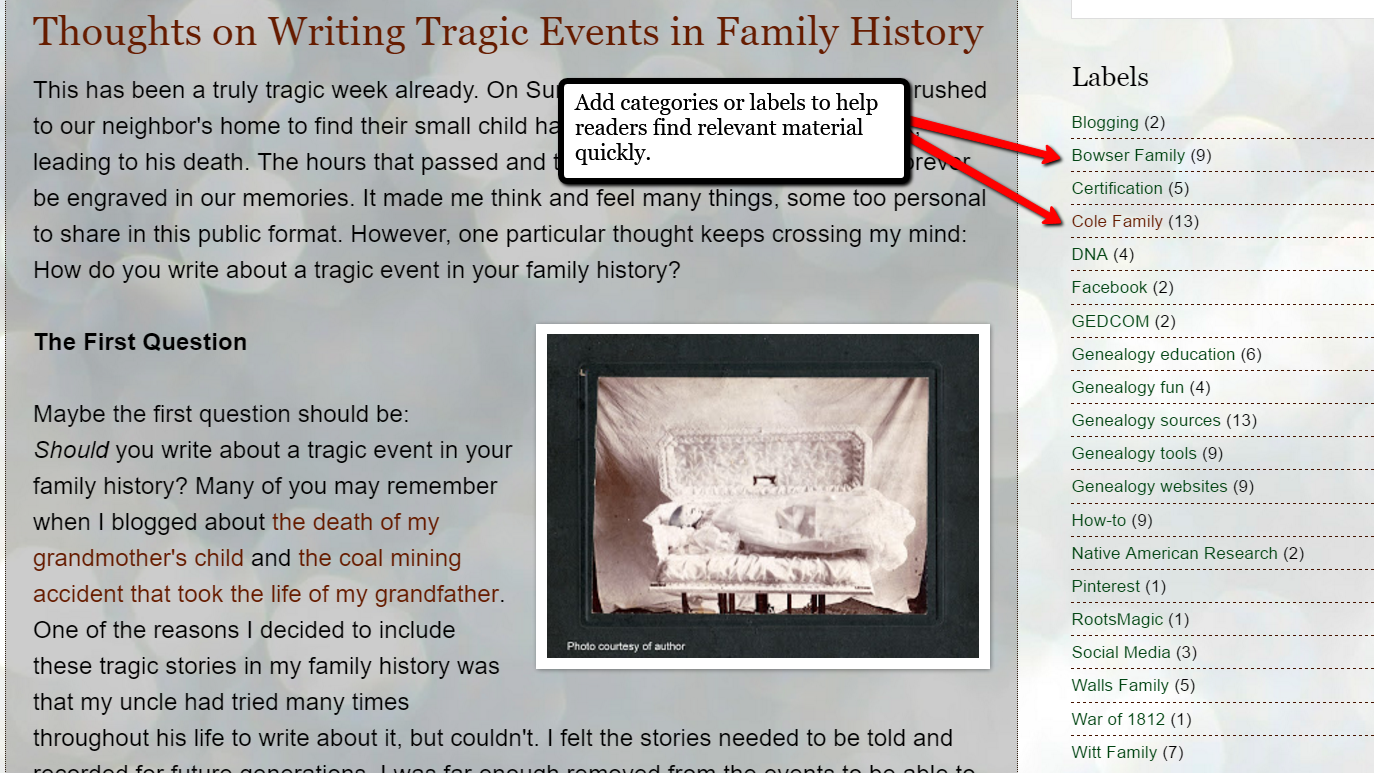
Categories and Labels are great for SEO too. Google loves well-organized websites because they are easier to understand and deliver in search results.
More Gems on Creating Your Own Genealogy Blog
Ruth wrote to tell me she has already started putting these ideas into practice. She’s on her way to rising in the search results and hearing from distant cousins. How exciting! Click below to continue reading about rewarding and effective family history blogging.
Why Marketing Experts Would Agree That You Should Write a Family History Blog
Why and How to Start a Family History Blog
Genealogy Blogging, the Future of Genealogy and More
Tell Us About Your Genealogy Blog
Do you have a genealogy blog? Well, here’s my call to action! Please share your family history blog, SEO tips, and success stories in the comments area below.
And I would so appreciate it if you would share Genealogy Gems with your friends and blog readers by including a link to our website in your list of favorite genealogy help sites on your blog. Thanks!
by Lisa Cooke | Apr 3, 2017 | 01 What's New, Oral History
Have you used WPA records for genealogy? Their Historical Record Surveys and local and oral histories may help you in your family history research. Existing records and locations vary widely. Here are tips to help you in your search.
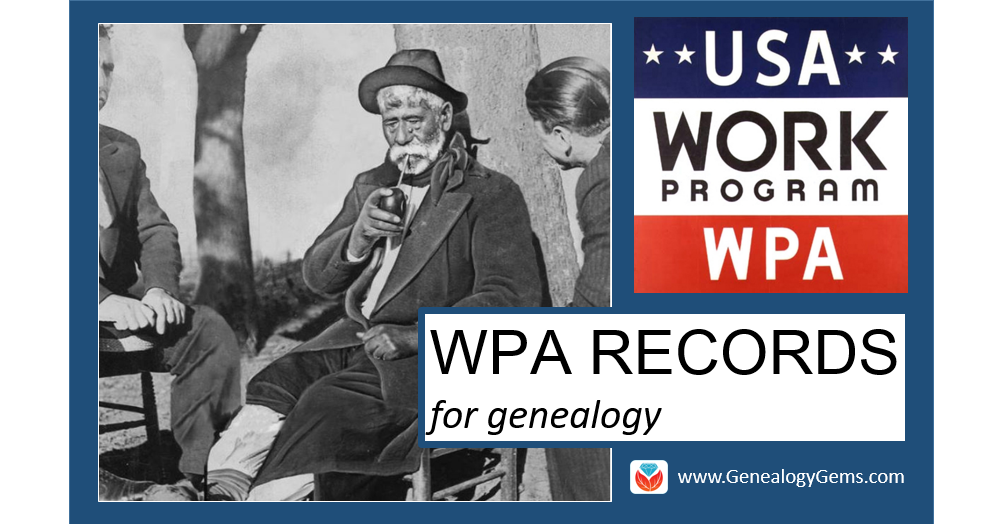
In the late 1930s and early 1940s, employees of the Works Progress Administration (WPA, also known as the Works Projects Administration) created new resources for U.S. genealogical research. It’s possible you’ve even consulted some of these without being aware of their WPA origins. After all, the projects and their formats varied. They didn’t always prominently credit the WPA and some were printed long afterward. We’re going to shine the spotlight on WPA-era local histories, oral histories and statewide Historical Record Surveys.
WPA Records for Genealogy: Local Histories
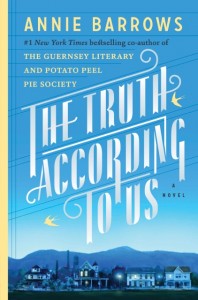 In Annie Barrows’ novel The Truth According to Us, Layla Beck heads to the small fictional town of Macedonia, West Virginia to write a local history as a WPA assignment. Drama ensues, both in Layla’s personal life and as she tries to learn local stories, which everyone reports a little differently. (We featured this book in the Genealogy Gems Book Club.)
In Annie Barrows’ novel The Truth According to Us, Layla Beck heads to the small fictional town of Macedonia, West Virginia to write a local history as a WPA assignment. Drama ensues, both in Layla’s personal life and as she tries to learn local stories, which everyone reports a little differently. (We featured this book in the Genealogy Gems Book Club.)
Actually, local histories were written as WPA projects. Their scope, topics, and formats varied, depending on the unique background and resources of each region and how active WPA workers were in each state and county. For example, WPA historical materials in Morrison County, Minnesota include “histories on townships, cities, churches, schools, businesses, the military, and miscellaneous county history topics,” which have since been collected and reprinted by the county historical society. Many historical projects included photographs, such as this one for the city of New Orleans.
WPA Records for Genealogy: Oral Histories
WPA workers also captured oral histories of individuals, too. Many were collected in American Life Histories: Manuscripts from the Federal Writers’ Project, 1936 to 1940, now online at the Library of Congress. According to the collection description, “The documents chronicle vivid life stories of Americans who lived at the turn of the century and include tales of meeting Billy the Kid, surviving the 1871 Chicago fire, pioneer journeys out West, factory work, and the immigrant experience. The documents often describe the informant’s physical appearance, family, education, income, occupation, political views, religion and mores.”
Other important WPA oral histories are narratives of former slaves and their families. You can browse an enormous collection of these online at the Library of Congress. These aren’t the ideal eyewitness accounts we wish for, as they were gathered so long after the end of slavery, from many who were young children at the time. Also, many researchers believe interviewees may not have spoken candidly, especially to white interviewers who may have known them personally.
It’s a long shot to find an ancestor mentioned by name in WPA oral histories. In some instances, pseudonyms were even used for names and places. But, you can still learn a lot from others’ descriptions of daily life and unusual events your ancestors may have experienced.
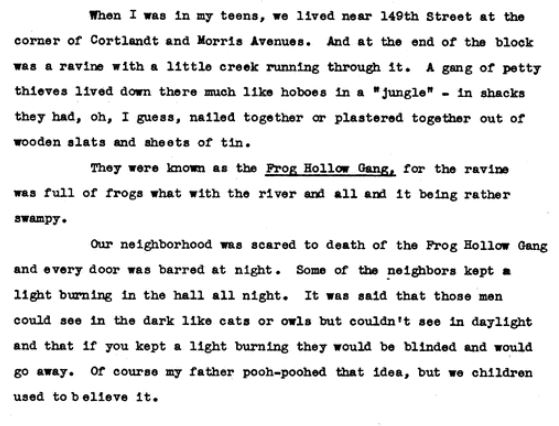
From one of the slave narratives mentioned in this article.
Historical Record Surveys
The Historical Record Surveys created by the WPA are among the most genealogically-valuable of their projects. “Under the auspices of the WPA, workers went to archives, historical societies, public and university libraries, and compiled inventories of manuscript collections,” writes Bryan Mulcahy in an online report. “They went to courthouses, town halls, offices in large cities, and vital statistics offices and inventoried records. Besides compiling indexes, they also transcribed some of the records they found.”
Today, many of their efforts still exist. They include indexes to cemeteries, newspapers, and naturalization records, as well as inventories of courthouse records, church records, and other manuscript collections in various archives or libraries. Of course, some records may have been moved or destroyed since inventories were created, but knowing what records existed around 1940 and what they were called may help you locate surviving collections. Some indexes, such as those of cemetery tombstone inscriptions, may actually be more valuable since they captured information from tombstones that may no longer exist or be legible.
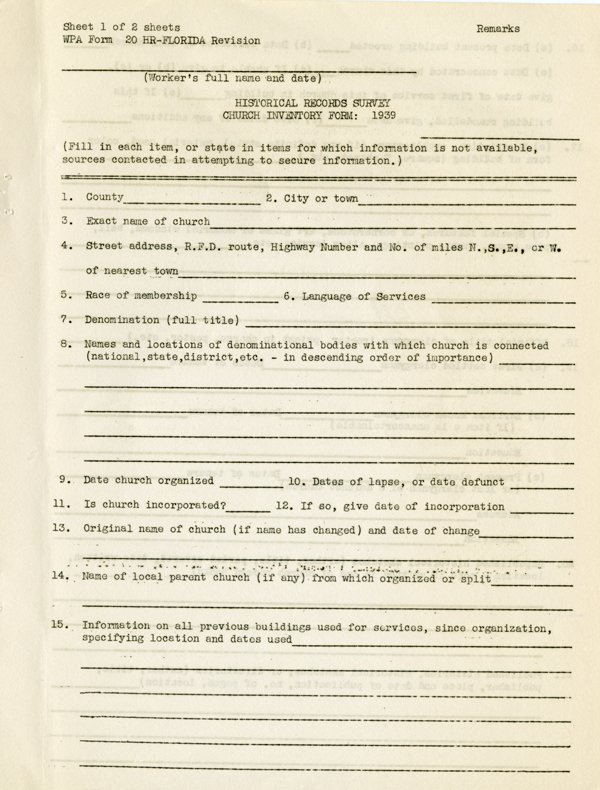
A blank WPA Historical Records Survey church records inventory form. Image courtesy of the State Archives of Florida. Click this image to find it online at Florida Memory.
One great example is the Historical Records Survey for the state of Oregon, described as “the most comprehensive documentary project of Oregon history and related records of its time.” It includes historical essays, document transcriptions, interviews, research notes, photographs, pamphlets and more. According to its collection description, “The territorial and pioneer periods of the mid-to-late nineteenth century receive the greatest attention, with an emphasis on the growth of state government and infrastructure, business and agriculture, transportation, education, biography, and relations between social groups. Native Americans figure prominently in this collection.”
Finding WPA Records for Genealogy Online
Some WPA projects were carried out on a federal level and others by state agencies. They were never centrally published or collected. Today, surviving original files and published volumes are scattered across the country. Some can be found in the National Archives, many in state libraries or societies, and many more available at local repositories.
A Google search such as historical records surveys and the name of the state and/or county is a great way to start your search for WPA records for genealogy research. Some results will lead right to the kinds of resources you want, such as this guide to WPA records in archives in the Pacific Northwest. Others, such as this one for the Iowa Historical Records Survey published in The American Archivist, are mostly a history of the effort. However, they do contain several useful bibliographic citations to records that were created. Add the name of the county to your search and you may find more targeted results, such as this library catalog entry for the inventory of the Jasper County archives. Click here to learn more about Google searches for genealogy records you want to find.
Remember, though, that many WPA publications and collections aren’t identified as such. Don’t fixate on needing to find WPA listed in the title. Just concentrate your efforts on finding the local and oral histories, photos, historical record indexes and inventories, and other resources that may be out there. When you find one created during the Great Depression, you’ll know it may have been done by the WPA.
 Love what you’re reading and want to learn more? Go deeper into genealogy “gems” like these in Lisa Louise Cooke’s Genealogy Gems Podcasts. Lisa produces a free internationally-renowned monthly podcast that’s had over 2.5 million downloads! Additionally, Genealogy Gems Premium website members also have access to her full archive of monthly Premium podcast epidodes: check out a full description of these here including Episode 2 on WPA records for genealogy.
Love what you’re reading and want to learn more? Go deeper into genealogy “gems” like these in Lisa Louise Cooke’s Genealogy Gems Podcasts. Lisa produces a free internationally-renowned monthly podcast that’s had over 2.5 million downloads! Additionally, Genealogy Gems Premium website members also have access to her full archive of monthly Premium podcast epidodes: check out a full description of these here including Episode 2 on WPA records for genealogy.









